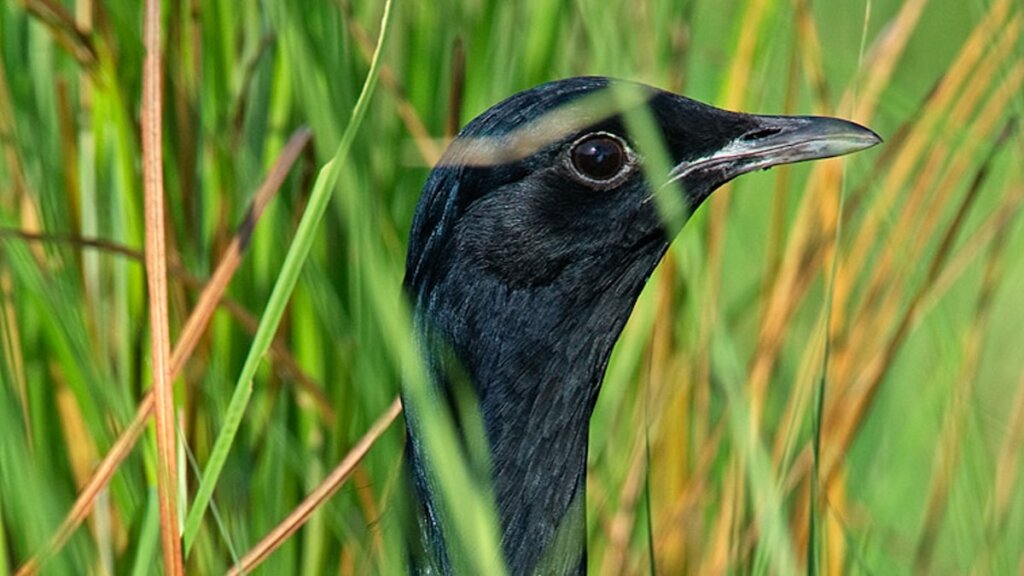The Resurgence of the Bengal Florican: From Threat to Conservation Success
Aerial Courtship Displays and the Role of the Bengal Florican in Ecosystem Diversity
During the breeding season, the male Bengal florican, distinguished by its sleek black plumage streaked with white beneath a mottled back, performs spectacular aerial leaps. As he ascends, his white wings spread wide, revealing a puffed black neck “pouch” that accentuates his display to attract females. The female, adorned in buff-brown and black tones, evaluates these displays before selecting her mate. This elaborate courtship ritual highlights the importance of the species within their habitat.
Today, visitors flock to Manas National Park, a UNESCO World Heritage site nestled in Assam, India, primarily to observe these elusive birds-the world’s rarest bustard-and other diverse wildlife. While the species’ comeback is promising, it is the result of decades of dedicated conservation efforts amid ongoing challenges.
The Critical Status of Bengal Florican and Population Recovery
The Bengal florican is classified as critically endangered by the International Union for Conservation of Nature (IUCN), with fewer than 800 individuals remaining worldwide. The largest known population, estimated between 350 and 400 birds, resides in northeastern India. A significant part of their recovery has been driven by local communities committed to safeguarding these two-foot-tall, three to four-pound birds, which once faced near-extinction due to extensive hunting and habitat loss.
Historical Threats and the Impact of Poaching
Ironically, many of the current conservation champions once hunted these birds. Rustam Basumatary, a member of the Bodo tribe from Khamardwasa village near Manas, recalls his youth when poaching was commonplace. “I started hunting with friends around the age of 14 or 15,” he admits. Using slingshots and bows, he and others hunted not only for sustenance but also to sell the surplus meat for income. Poverty was a significant driver, pushing marginalized communities to rely on wildlife as a survival strategy.
Between the late 1980s and early 2000s, political unrest and conflict between the Bodo community and the Indian government left Manas National Park vulnerable. The absence of effective patrols and administrative oversight led to rampant poaching, not only of Bengal floricans but also of iconic species like rhinoceroses. During this period, illegal hunting decimated wildlife populations, threatening the ecological balance of the region.
Transition from Poachers to Protectors: Community-Led Conservation
The peace process that culminated in the Bodo Accord in 2003 marked a turning point. A group of about 100 individuals formed the Manas Maozigendri Ecotourism Society (MMES), aiming to restore the park’s ecological integrity. Rustam Basumatary, once a poacher, became a key figure in this transformation, advocating for the protection of local wildlife.
The MMES launched outreach programs to educate villagers about the importance of conservation. Partnering with organizations like Aaranyak, a prominent environmental NGO, they emphasized the legal and environmental consequences of poaching-ranging from imprisonment to ecological degradation-and encouraged community members to channel their skills into protection efforts.
Initially, transitioning from hunting to conservation was challenging, as poaching had been a primary livelihood for many. To ease this shift, NGOs provided essential supplies, including food rations, for a few months, and local authorities actively promoted the surrender of illegal weapons. These measures helped alleviate fears and fostered a sense of pride in protecting their natural heritage.
Community Engagement and Policy Support
By 2006 and 2007, over 60 firearms had been voluntarily handed over by villagers, signaling a significant shift in attitude. The success of these efforts was reflected in the removal of Manas from the UNESCO list of World Heritage sites in danger in 2011, a milestone that underscored the effectiveness of community-led conservation.
Today, more than 800 volunteers, many of whom are former poachers or local residents, are formally engaged in wildlife protection and forest management activities, according to the Bodoland Territorial Council. This widespread community involvement has become a cornerstone of ongoing conservation success.
Ecotourism and Socioeconomic Benefits
The revival of ecotourism centered around the Bengal florican has brought tangible benefits to local communities. During the breeding season from November to June, over 2,000 families around Manas earn approximately $400 to $450 per month by hosting tourists eager to witness the bird’s legendary courtship dance. This income has transformed the narrative-from one of hunting for survival to one of sustainable livelihood.
Signs of Hope: Population Trends and Future Outlook
Despite its critically endangered status, recent studies indicate positive trends. A 2024 survey published in the Journal of Threatened Taxa recorded an increase of ten Bengal floricans in Manas compared to data from 2011. Experts interpret this as an encouraging sign of recovery, emphasizing that conservation efforts are bearing fruit.
The Cultural Significance and Ongoing Challenges
Today, the Bengal florican has become a symbol of regional pride and ecological resilience. Rustam Basumatary reflects, “We are proud to protect this rare bird and showcase its unique behaviors to the world.” While challenges remain, including habitat encroachment and climate change, the collective efforts of communities, NGOs, and government agencies continue to foster hope for the species’ future.
As conservation initiatives expand and awareness grows, the Bengal florican’s story exemplifies how local action can turn the tide against extinction, transforming former threats into opportunities for ecological and social renewal.

